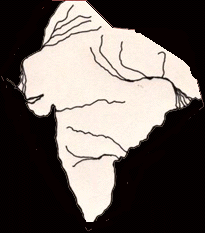| Art History 207~~Fall 1998 |
| Study Questions |
| Week 3 |
| The late Hinayana chaitya; the Kushan period and Mahayana Buddhism; the styles of Mathura and Gandhara. |
|
1. Compare the Friar Bala Bodhisattva to the Parkham yaksha: how does the first seem to derive from the second? What important changes have occurred? 2. The seated Buddha from Katra functions as a kind of text of meaning. How does the figure express a sense of immediacy? of concern and compassion? What is the significance of the fly-wisk bearers, of the lions, and of the bodhi-tree at the back? Use this figure to understand how one can learn to 'read' a Buddhist sculpture. 3. Think about the chaitya halls at Bhaja and Karli. Would you describe them as sculpture or as architecture? Why? 4. What ideals of form are represented by the Karli donor figures? 5. How did the chaitya hall at Karli create art gradually increasing sense of religious experience for the worshipper? Think about the shift from outside to deep inside the hall. Think about what happened to light as one moved into the hall. Sites of the Week :
a) Karli Further Readings:Conze, Edward. Buddhist thought in India: three phases of Buddhist philosophy. London; Boston: Allen & Unwin, 1983.. Paul, Diana Y. Women in Buddhism: images of the feminine in Mahayana tradition. Berkeley: Asian Humanities Press, 1979. Akiyama, Aisaburo.Buddhist hand-symbol. Yokohama, Yoshikawa Book Store, 1939. Rosenfield, John M. The dynastic arts of the Kushans. Berkeley, University of California Press, 1967. Hallade, Madeleine.Gandharan art of North India and the Graeco-Buddhist tradition in India, Persia, and Central Asia. New York, H.N. Abrams [1968] |
| The Gupta Period: late Buddhist art and the Sarnath and Mathura styles; early Hindu sculpture at Udayagiri and Deogarh. |
|
1. What are the main stylistic differences between the Buddhist sculpture of Sarnath and that of Mathura? 2. Who is the god Vishnu? What aspects of his power are indicated in the shrine at Udayagiri? What aspects are indicated in the panel of Vishnu Anantasayin, at Deogarh? 3. Explain how those two relief sculptures of Vishnu combine symbols of opposite forces in order to express the Hindu concept of ultimate unity. 4. Compare the doorway at Dasavatara Temple with one of the torana from Sanci: how does the temple doorway continue a tradition of symbolic entrances in Indian art? 5. Think about ornament in Indian art so far, as at Bharhut, Sanci, Karli, and Dasavatar Temple: what kinds of ornamental elements seem to be continuing themes? why? 6. The early Western powers in India condemned Hindu art as being idolatrous Despite the many images of deities in that tradition, why is it incorrect to say that the Indians were 'idol worshippers'? Sites of the Week :
a) Udayagiri Further readings:Banerji, Rakhal Das. The age of the imperial Guptas. Benares Hindu University, 1993. Williams, Joanna G. The art of Gupta India: empire and province. Princeton, N.J.: Princeton University Press, c.1982. |


